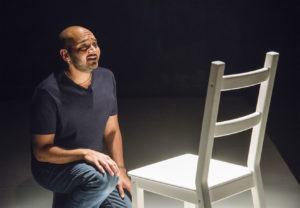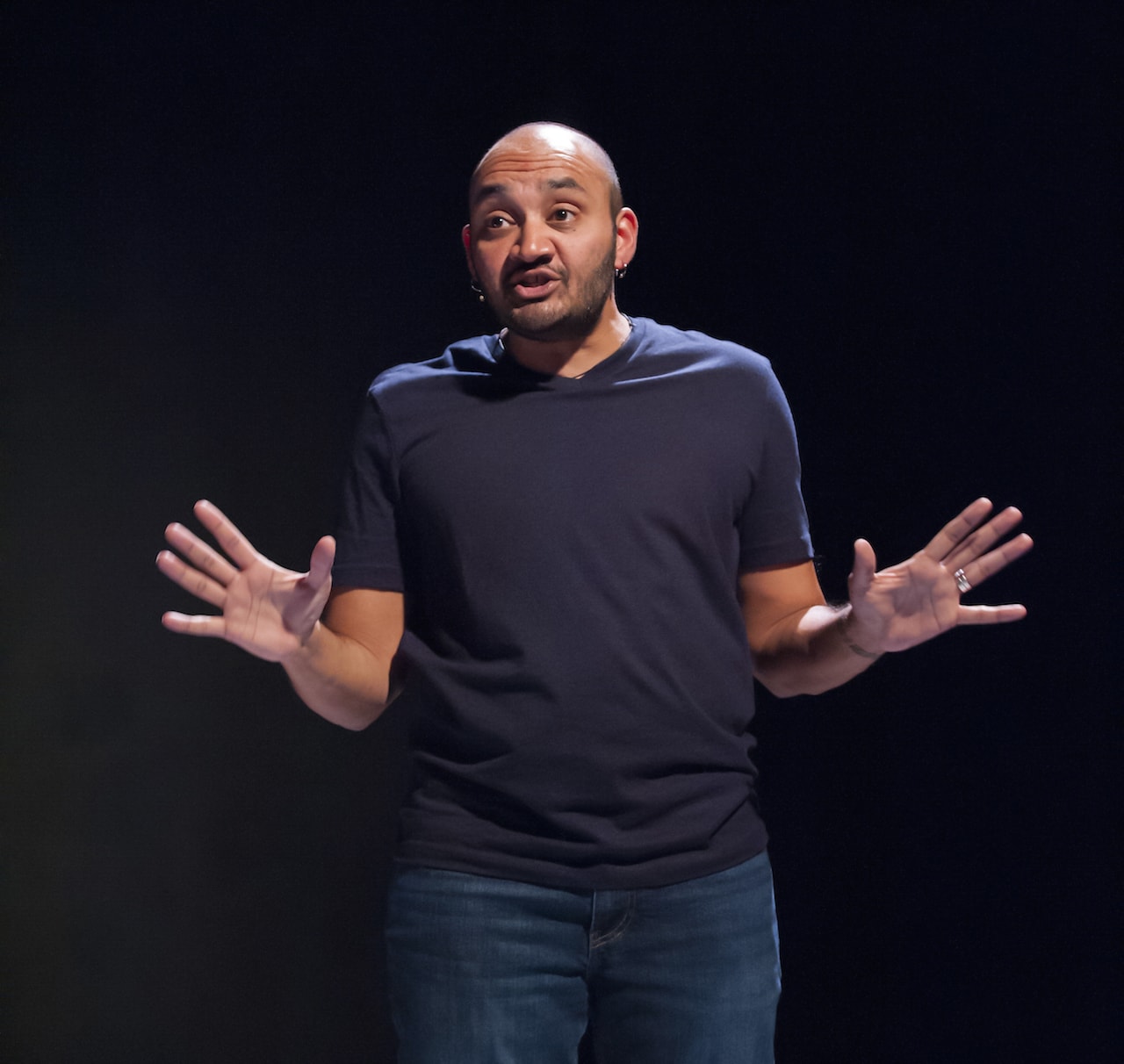Draw the Circle is no ordinary one-man show. Nor is it an ordinary autobiographical play. Because Mashuq Mushtaq Deen—its transgender playwright and solo performer—has a singularly fascinating life story to tell. And the way he tells it is even more amazing.
When Deen was born into his conservative Muslim family, he was assigned female. That today would make him a twofer target for trumpian animus. Also: a doubly underrepresented voice in theater.

Mosaic Theater Company has staged stories that include trans characters before (notably When January Feels Like Summer and Charm), but Draw the Circle is the first time Mosaic has invited a transgender author to tell their own story. If you believe theater at its best is a big tent, that’s huge news.
As we enter the Lab II black box at Atlas Performing Center, a color photograph of a girl of about eight appears on an upstage screen. She’s wearing long hair and a dress and looking at the camera warily. The stage floor is a white square set with only a white chair. Deen enters and without ado goes into character as the people in his story. They include his mother, his father, the woman who is his romantic partner in life, and others. His voice and body alter for each; as they appear in the play, they are identified on the projection screen—Mother, Father, Molly, and so on. We read to know who’s who. We watch to see what they say and do. The effect of Deen’s storytelling technique and artistry is arresting.
Unlike some transfolk who prefer not to revisit their pre-transition lives, Deen is transparent about his. That photo onscreen was him as a child, when his name was Shireen. With his gentle humor, his agile portrayals, and a grippingly self-aware narrative, Deen takes us on his journey to become the man we see before us.

And here’s the most amazing thing: We see Deen in front of us, performing the parts of other people in his life, getting inside their hearts and minds, embodying them as they talk to and about him—their concerns for him, their reservations, their affections and disaffections. Yet Dean himself never speaks a word. Not a single first-person utterance we hear is his.

When sometimes the white chair stands in for someone a character is talking to, there’s suddenly a two-hander scene done one-handed. When even his most tormented inner life finds expression, it is as observed and reflected by another person, a character into whom he has entered in order that we may know him. The character of the man Deen becomes is consequently only ever inferred or construed or filled in by us. In order to follow his story, we necessarily become conscious and empathic witnesses, seeking to understand him, not being told how to, completing his story of seeking to be seen. The way as writer/performer Deen lets us know him through his transformation only through everyone else’s point of view is a masterful act of writing and performance that transforms us.
Dean’s story is at times harrowing. We learn of the period he was suicidal, cutting himself, such was his pre-transition distress. At times his story is just mind-blowing. Shireen and Molly meet and fall in love in what to all appearances was a lesbian relationship. Years after his transition, Deen and Molly’s relationship endures.
The play talks plainly about the details: the hormones, breast binding, top surgery, strap-on dildos, pack ‘n’ pees. More important, though, Molly speaks with enthralling honestly about what’s going on between her and this very butch person whom she loves. A dramatic turning point occurs when Molly realizes Shireen wants desperately and simply to be seen as “he.” But in the real world of other people’s gender stereotyping, that cannot happen for him without hormones and surgery. And so begins Molly’s way forward to acceptance.
A trigger warning: At a point about midway, Deen knocks over the chair, it crashes violently to the stage, he tells us he is going to tell us about “the rape,” and he does.

Draw the Circle was directed by Chay Yew, who also designed the set, with lighting by Mary Louise Gieger and E-hui Woo and sound by Matthew M. Nielson. The entire production is spare, without ostentation or embellishment, the better to focus our attention on the man emerging as others see him: as the man he wants to become.
And who exactly might that man be?
There’s a blazing zone of illumination during Draw the Circle when we learn Deen wants to be a man but does not want to be like men who rape, men whom he knows all too well from living life as a woman. The moment seems almost oracular, as if from Teiresias with #MeToo tears.
“What does it mean to be a man? What does it mean to be a woman?” Deen asks. “What’s the difference?” What indeed.
If you believe theater can teach us something important about who we are as gendered beings—or even if you just have a hunch that America cannot be great if driven by hate—Draw the Circle is an epochal inquiry into identity…and some of the most pressing questions of our time.
Running Time: About 80 minutes, with no intermission.
Draw the Circle plays through December 24, 2017, at Mosaic Theater Company of DC performing in Lab II at Atlas Performing Arts Center – 1333 H Street NE, in Washington, D.C.. For tickets, call the box office at (202) 399-7993 ext. 2, or purchase them online.
Mashuq Mushtaq Deen’s Draw the Circle plays in rep with Dan Hoyle’s The Real Americans. See Review: ‘The Real Americans’ at Mosaic Theater Company by
VIDEO:




